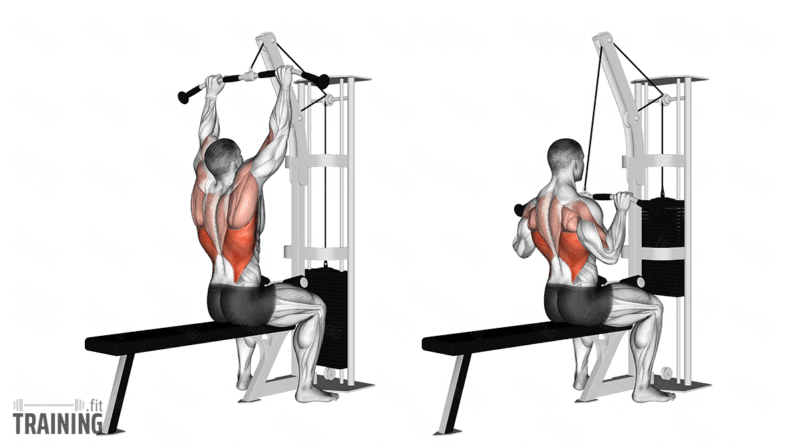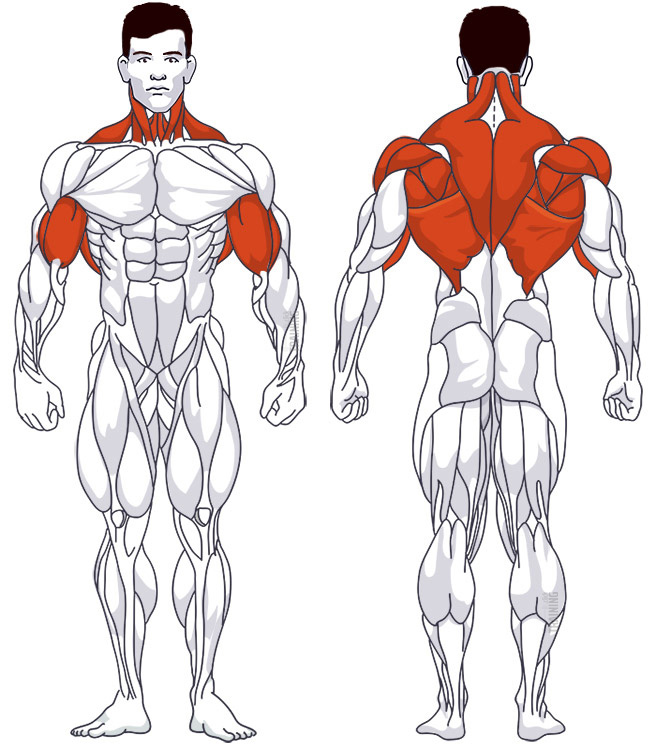Cable Lat Pulldown, close grip
Compound exercise, Cable pullOverview

Main muscles
- Biceps: Arm flexor
(Musculus biceps brachii) - Neck: Trapezius muscle
(Musculus trapezius) - Back: Large round muscle
(Musculus teres major) - Back: Large back muscle
(Musculus latissimus dorsi) - Back: Larger rhomboid muscle
(Musculus rhomboideus major) - Back: Small round muscle
(Musculus teres minor) - Shoulder: Posterior deltoid muscle
(Musculus deltoideus, posterior deltoid muscle)
Training plans
Here you can find example plans for cable lat pulldown, close grip training:
Cable Lat Pulldown, close grip: Basics and alternatives

Involved main muscle groups:
Cable Lat Pulldown, close grip
The close grip lat pulldown is an exercise targeting the latissimus dorsi, the largest muscle in the back. It’s a modified version of the standard lat pulldown with a tighter grip. You’ll sit on the cable machine’s bench and pull the lat bar down in front of your chest with a close grip. This exercise not only works the large back muscle but also activates the neck, posterior shoulder, and biceps.
The close grip lat pulldown is suitable for both beginners and advanced exercisers. It’s especially helpful for beginners, as it prepares your muscles for pull-ups using a lower training weight. Once you can confidently perform multiple pull-ups with your body weight, you can replace this exercise with pull-ups.
Correct execution
There’s some debate over the ideal grip width for lat pulldowns. On the lat pulldown exercise page, we mentioned two studies showing that muscle activation differences between various grip widths are relatively small.
In short, there’s no significant difference in maximum strength sets, while a medium grip width was most beneficial for medium strength sets with 6 reps. The narrow grip showed similar muscle activation and maximum repetition loads.
So, what does this mean? You can confidently use a close grip and switch between different grip widths without any issues.
Additionally, you can vary the grip itself, using either an overhand grip (back of the hand facing backward) or an underhand grip (back of the hand facing forward). The underhand grip activates the biceps and chest more, while slightly less engaging the lat muscle.
The grip width and variation you choose ultimately comes down to personal preference. If you’re a beginner, try out different options to find what works best for your body.
Video tutorial
Step-by-step instructions
Adjust the weight and stand in front of the bench.
Grab the lat bar with a tight overhand or underhand grip (see above) and sit with arms extended toward the bar. The training weight might move a bit at this point. Place your knees/thighs under the designated pads (if available) to secure your body.
Pull your shoulders back slightly and form a small arch in your back. You’re now in the starting position.
Pull the lat bar down in front of your chest, keeping your elbows close to your body. Imagine moving the weight toward your hips, not behind your back, and follow this movement. Only at the end of the pulling motion should your elbows move slightly behind your back. Hold this position for a moment.
Slowly raise the weight back to the starting position in a controlled motion.
Common mistakes
A classic strength-training mistake with the close grip lat pulldown is using momentum to move the weight. Lifting your butt off the bench and then lowering your body with a swing might help you move more weight, but it significantly reduces the workout’s effectiveness. Additionally, the uncontrolled swinging motion when lowering the weight puts extra stress on your joints. So, always perform the exercise with controlled and clean movements, reducing the weight if needed.
Another common mistake involves the position of your elbows. As mentioned earlier, try not to immediately pull your elbows behind your back during the pulling motion. Instead, guide them toward your hips, keeping them close to your body. Only at the end of the movement should your elbows push slightly backward.